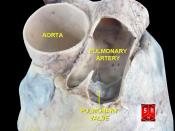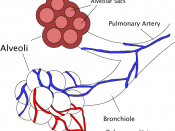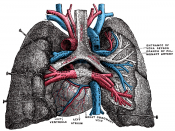1) Blood enters the heart from the body through the large veins called the superior and inferior vena cava. This deoxygenated blood goes into the right atrium. From there it is pumped pass the atrioventricular valve into the right ventricle. The right ventricle pumps the blood out of the heart pass a semilunar valve into the Pulmonary artery. Blood travels through the Pulmonary artery into the lungs, where it is oxygenated and carried through the Pulmonary vein back into the heart. The blood comes in to the left atrium and is pumped pass another atrioventricular valve into the left ventricle. Blood then is pumped through another semilunar into the aorta and out of the heart.
2) There are three types of blood vessels in the body. Arteries carry blood away from the heart and have thick somewhat flexible walls. Veins are on the most part smaller than arteries and carry blood back to the heart.
They have thinner and more flexible walls. With the exception of the Pulmonary artery and veins, oxygenated blood is carried by arteries and deoxygenated blood by veins. Capillaries are small blood vessels, only one blood cell thick, that connect the veins and arteries.
3) Amphibians have three chambered hearts, with two atria and one ventricle. When blood is pumped into the ventricle, it pumps blood into a divided vessel. One side of it is called the systemic circuit and the other is called the pulmonary circuit. The systemic circuit carries mostly oxygenated blood to the body. The blood then goes into the right atrium, where it is pumped into the ventricle. Most of this now deoxygenated blood goes into the pulmonary circuit. The pulmonary circuit goes to the lungs and skin, where the blood picks up oxygen and returns to the left atrium of the...


